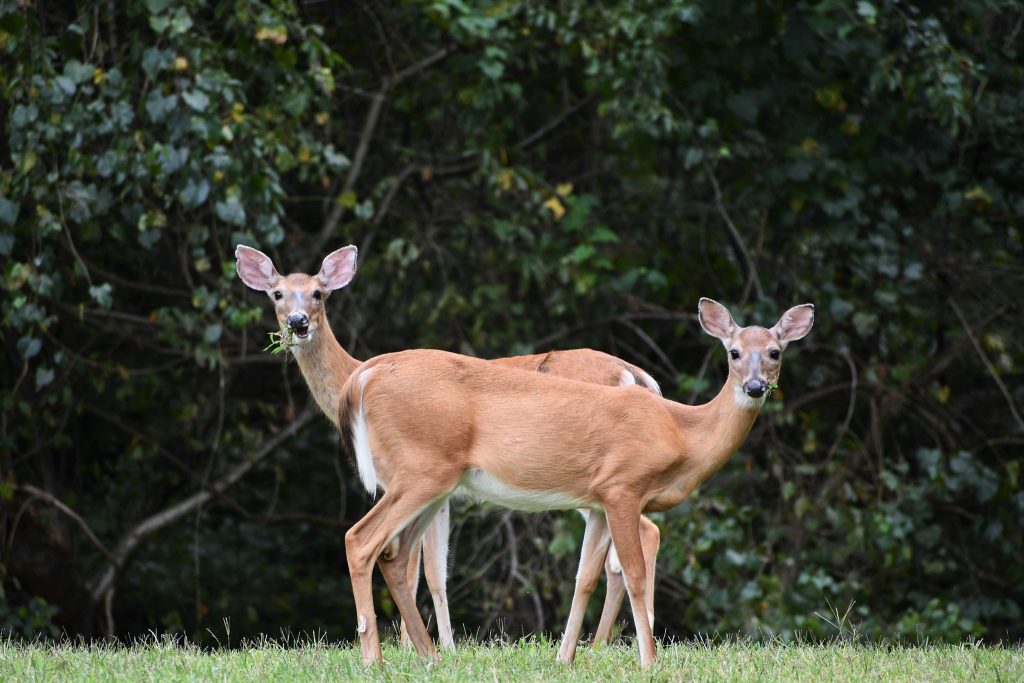Overpopulation of deer can reduce a forest’s ability to regenerate

Deer eating at the edge of a forest. Photo by Deepti Bansal Gage, submitted to the 2019 Maryland DNR Photo Contest
Maryland is home to a diversity of native wildlife and plant species, and the balance between the two can sometimes be difficult to manage. Like rabbits overrunning a garden, an overpopulation of deer will have detrimental effects on the undergrowth and vegetation in a forest.
For the Maryland Forest Service, successful stewardship requires finding equilibrium between supporting sustainable woodlands and affording space for the white-tailed deer that reside there. Deer browse on fresh tree buds and leaves that spring up from the forest floor. This is a natural part of their diet, but in the face of shrinking landscapes and fewer hunters, overpopulation of deer is leading to over-browsing.
Since 2005, Maryland’s white-tailed deer population has stabilized around 235,000 deer. This was a stark decrease from the state high of 300,000 in 2002 after growing from an average population of around 150,000 deer in the 1980s until 1993. Meanwhile, the number of licensed hunters in the state has dropped by more than 40% since the 1970s. Since 2010, the white-tailed deer harvest has declined by more than 20%. The combination of less hunters and more deer since the 1980s and 1990s is damaging overall forest health.
In forests with dense deer numbers, the impact of deer can be plainly visible in the “browse line”—the area of vegetation extending from the ground to about six feet above the forest floor. If you see plants nibbled within the browse line, limited plant regrowth, or an abundance of invasive plants, then there are likely too many deer and not enough native trees and shrubs. This type of activity means young forest growth is being suppressed, which removes habitat from other wildlife such as turkeys, quail, and pollinating insects. Some of these species are already dwindling in numbers and facing an uphill climb.
As the native vegetation is reduced and eliminated, there is less competition for the many species of non-native, invasive plants that quickly attempt to occupy every last nook and cranny of our forests. Deer-browsed spaces suddenly become filled with invasives such as Japanese stiltgrass, wisteria, and kudzu that use the sunlight, water, and nutrients needed for native plant growth. And since native wildlife eats native vegetation, there is less habitat and food for all, including deer.
Browsing isn’t the only form of damage deer inflict. Each fall, bucks rub their antlers on trees as part of their mating behavior. These “buck rubs” can shred bark and cause tissue damage to still developing trees, stunting growth and creating opportunities for pathogens or insects to inflict additional damage.
To help prevent deer browsing damage, the Maryland Forest Service uses tree shelters to allow our seedlings to get close to or above the browse height. Shelters include the noticeable plastic tubes you may have seen around the state at tree planting sites, which are the most cost-effective mechanism to prevent browsing damage. Shrub cages and fencing are also other alternatives that can be employed to protect and preserve vegetation, depending on cost. There are scent, audio, and visual repellents too, but those products are not as effective as tree tubes or fencing.
Other solutions to the issue include recruiting new and reactivating lapsed hunters through hunter education programs and hunting programs, which DNR offers throughout the year. Another option could be to make hunting on Sundays more accessible in the state. Maryland is one of 10 states in the U.S. that still has colonial-era laws that restrict Sunday hunting in several counties, despite a strong track record of hunting safety. Liberalizing Sunday hunting regulations could enable hunters to more easily find time to harvest a deer, teach others how to hunt, and provide increased economic opportunities for guides, outfitters, and outdoor businesses. Earlier this year, the Pennsylvania legislature repealed its longtime ban on Sunday hunting for similar reasons.
By Francis Smith, natural resources planner with the Maryland Forest Service.
